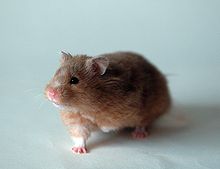
Golden hamster

The golden or Syrian hamster (Mesocricetus auratus) is a rodent belonging to the hamster subfamily, Cricetinae. Their natural geographical range is limited to arid areas of northern Syria and southern Turkey. Their numbers have been declining in the wild due to a loss of habitat from agriculture and deliberate elimination by humans. Thus, wild golden hamsters are now considered vulnerable by the International Union for Conservation of Nature. However, captive breeding programs are well-established, and captive-bred golden hamsters are often kept as small house pets. But they are larger than many of the dwarf hamsters kept as pocket pets (up to 5x larger), and so weigh about the same as a sugar glider. They are also used as scientific research animals throughout the world. The size of adult animals ranges from 5 to 7 in (13 to 18 cm) long, with a lifespan of two to three years (3–4 years in domestic homes, 2–3 years in the wild). Body mass is in the range of 120-125 g. Like most members of the subfamily, the golden hamster has expandable cheek pouches, which extend from its cheeks to its shoulders. In the wild, hamsters are larder hoarders; they use their cheek pouches to transport food to their burrows. Their name in the local Arabic dialect where they were found roughly translates to 'mister saddlebags' (Arabic: أبو جراب) due to the amount of storage space in their cheek pouches. If food is plentiful, the hamster stores it in large amounts Sexually mature female hamsters come into season (estrus) every four days. Golden hamsters and other species in the genus Mesocricetus have the shortest gestation period in any known placental mammal at around 16 days. Gestation has been known to last up to 21 days, but this is rare and almost always includes complications. They can produce large litters of 20 or more young, although the average litter size is between eight and 10 pups. If a mother hamster is inexperienced or feels threatened, she may abandon or eat her pups. A female hamster enters estrus almost immediately after giving birth, and can become pregnant despite already having a litter. This act puts stress on the mother's body and often results in very weak and undernourished young. Golden hamsters originate from Syria and were first described and officially named in 1839 by British zoologist George Robert Waterhouse. Waterhouse's original specimen was a female hamster; he named it Cricetus auratus or the 'golden hamster'. The skin of the specimen is kept at the Natural History Museum in London. In 1930, Israel Aharoni, a zoologist and professor at the Hebrew University of Jerusalem, captured a mother hamster and her litter of pups in Aleppo, Syria. The hamsters were bred in Jerusalem as laboratory animals. Some escaped from the cage through a hole in the floor, and most of the wild golden hamsters in Israel today are believed to be descended from this litter. Descendants of the captive hamsters were shipped to Britain in 1931, where they came under the care of the Wellcome Bureau of Scientific Research. They bred well and two more pairs were given to the Zoological Society of London in 1932. The descendants of these were passed on to private breeders in 1937. A separate stock of hamsters was exported from Syria to the United States in 1971, but apparently none of today's North American pets is descended from these (at least in the female line), because recent mitochondrial DNA studies have established that all domestic golden hamsters are descended from one female – probably the one captured in 1930 in Syria.
